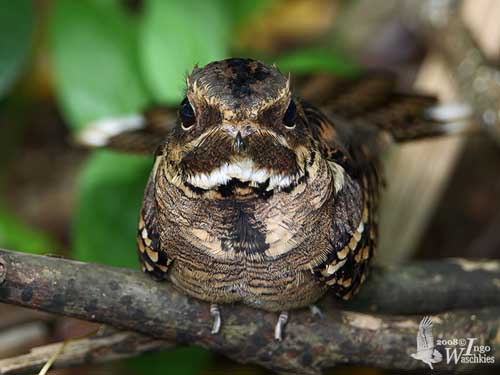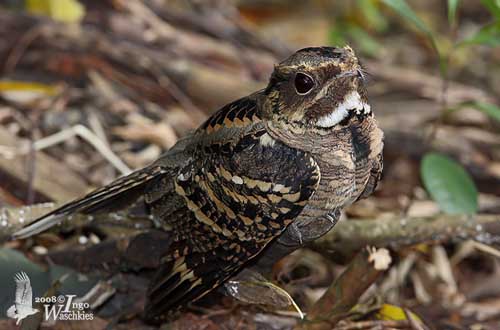
Fr: Engoulevent de Horsfield
All : Langschwanz-Nachtschwalbe
Esp : Chotacabras Macruro
Ital : Succiacapre codalunga
Nd : Horsfield-nachtzwaluw
Photographer :
Ingo Waschkies
Bird Photography
Text by Nicole Bouglouan
Sources :
HANDBOOK OF THE BIRDS OF THE WORLD Vol 5 by Josep del Hoyo-Andrew Elliott-Jordi Sargatal - Lynx Edicions - ISBN: 8487334253
A Field Guide to the Birds of South-East Asia by Craig Robson. New Holland Publishers. ISBN: 9781780090498
BirdLife International (BirdLife International)
Sungei Buloh Wetlands Reserve (Michael Mastaller)
XENO-CANTO – Sharing Birds sounds from around the world
Large-tailed Nightjar
Caprimulgus macrurus
Caprimulgiforme Order – Caprimulgidae Family
BIOMETRICS:
Length: 25-33 cm
Weight: 55-78 g
DESCRIPTION:
The Large-tailed Nightjar is a cryptic bird which lives mostly by night. During the day, it spends most of its time resting among dead leaves on the ground, enjoying its perfect camouflaged plumage.
The Large-tailed Nightjar’s plumage looks like leaf litter. It is greyish brown, with white throat patch. Underparts are buff, finely barred with blackish. Its cryptically brown and grey plumage with numerous spots and streaks, allows it to blend in with its surrounding.
The male shows conspicuous white patches on outer primaries, and broad white tips to outer tail feathers.

The female has smaller and buffer wing patch, and narrower, buffer tail patches.
The juvenile resembles female, with paler and buffer plumage, dusky and less indistinct tail patch.
The Large-tailed Nightjar has special bill, which can enlarge into an enormous “scoop” for catching insects in flight. The bill is greyish, short but wide. We can see a conspicuous line of bristles fringing the bill. It has brightly coloured mouth, which can suddenly gape open to startle a predator.
Eyes are dark, becoming red at night under the light. Legs are short, feet are small.
We can find 7 subspecies sharing the range. They differ in size and overall pattern and coloration.
VOICE: SOUNDS BY XENO-CANTO
The Large-tailed Nightjar’s call is monotonous. It is a strange hollow sound “chonk, chonk, chonk…” as knocking on wood. It repeats this sound from a perch or the ground, mainly at dawn and dusk. This is probably its territorial call. During the breeding season, it often calls from a perch or a branch. It is often called “hammer-bird” or “carpenter”.
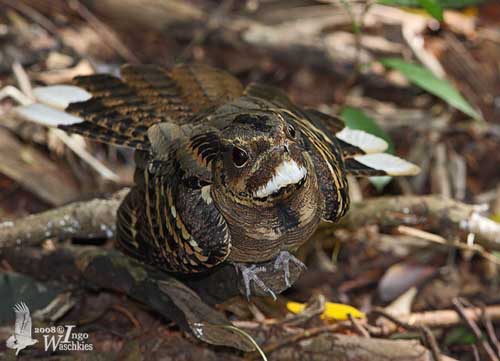
HABITAT:
The Large-tailed Nightjar frequents open forests, second growth, woodlands, scrub and plantations, open and humid areas such as mangroves, forest edges and cultivated fields.
This species can be seen from sea-level up to 2700 metres in the northern parts of the range. The elevation varies according to the location, from 460-900 metres to 1200 and 2000 or more.
RANGE:
The Large-tailed Nightjar occurs from Asia, throughout Asia and Papua New Guinea, and N/NE Australia.
BEHAVIOUR:
The Large-tailed Nightjar spends the day sit motionless on the ground, camouflaged among dead leaves thanks to the cryptic plumage. It also perches on low branch, against the bark, where its colours make it difficult to see.
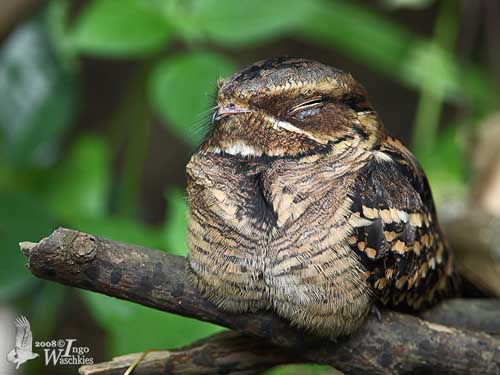
It hunts from a perch, waiting for prey. Then, it swoops down and catches it on the wing. It flies low over the ground. It also may perch on street lamps, where insects are attracted to the light, mainly after rain. It is very active at dusk.
It may hovers near cattle, taking advantage of the flushed preys.
The courtship displays show both mates close to each other, uttering a low croaking which takes part of pair bonding ritual. The male displays the white crescent on its puffed-out throat.
The Large-tailed Nightjar performs distraction displays if disturbed or threatened at nest. It tries to fly in other direction, flapping on the ground as injured or with a broken wing, in order to drive the intruder away from the nest site.
These displays are accompanied by guttural hissing sounds.
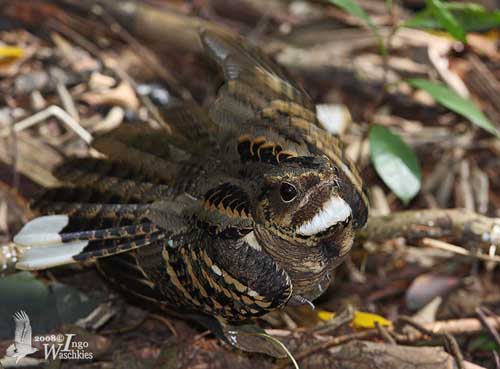
The Large-tailed Nightjar does not migrate, and only performs some local movements.
FLIGHT:
The Large-tailed Nightjar starts to fly after sunset. Its flight is almost similar to moth’s flight. It flies low over the ground when hunting. Its long and pointed wings and tail make it an acrobatic and silent flier.
When it pursues insects, it performs an untidy and capricious flight, hawking them while flying.
REPRODUCTION:
The Large-tailed Nightjar breeds from March to June. The nightjars do not build any nest. The eggs are laid in a shallow depression of the ground. This depression is often situated in shady area, under tree or bush.
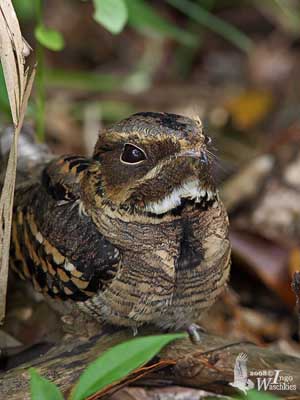
The female lays one or two mottled eggs. They are well camouflaged, looking like pebbles. Usually, the first egg laid is larger than the second. Incubation lasts about 16 to 18 days, shared by both parents taking turns for brooding the eggs, the female mostly by day, and the male at night. The young fledge at about three weeks of age.
At hatching, the chicks are covered in buff down, and they can move away from the nest about one or two days after hatching. They move every night to avoid detection, and may rest separately. During the day, they remain among leaf litter, well camouflaged by their brownish feathers.
The female probably cares for them until they can fly. She performs some distraction displays and moves away from eggs and chicks if threatened at nest. When alarmed, the young flap their wings and show wide open bills, in order to defend themselves.
DIET:
The Large-tailed Nightjar feeds mainly on insects, such as moths, crickets, grasshoppers, wasps, bugs, large beetles and mosquitoes, and it is fond of flying termite swarms.
PROTECTION / THREATS / STATUS:
The Large-tailed Nightjars are threatened by disturbances and habitat loss. But currently, they are still rather common and not endangered.
